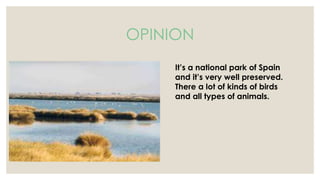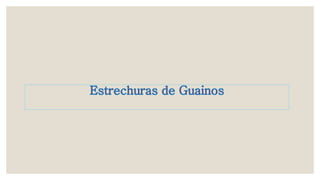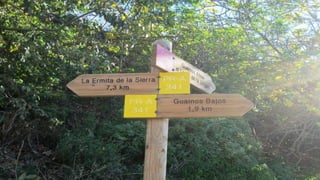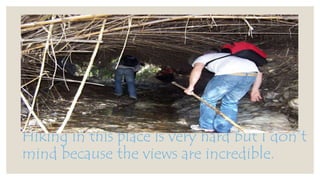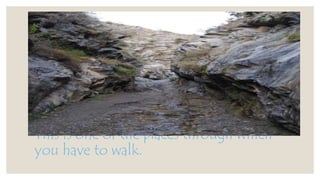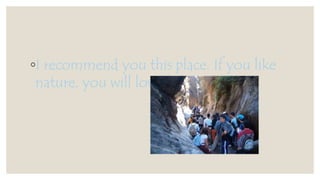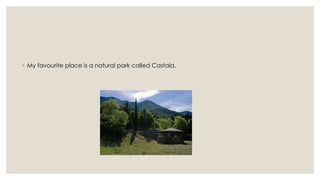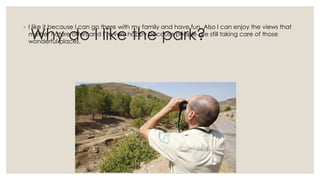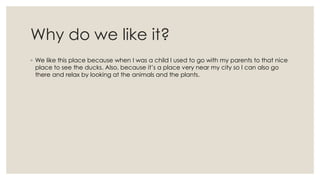Mis lugares Favoritos
- 1. MY FAVOURITE PLACE IN MY COUNTRY
- 2. DOÑANA
- 3. LOCATION Doñana National Park is a natural reserve in Andalusia, Southern Spain, in the provinces of Huelva and Seville. It covers 543 km2 of which 135 km2 are a protected area.
- 4. FLORA There are many species of flora in the park: trees, including pines, flowers such as roses, and shrubs.
- 5. FAUNA The Iberian lynx, whose habitat is restricted to the Iberian Peninsula, is the most endangered of the big cats. Only there are 50 lynx in Doñana.
- 6. DEERS The deer is a animal that have a flexible body with long and strong legs. It an excellent swimmer. The deer usually live in mountains or forest. It’s a typical species in Doñana.
- 7. CLIMATE Doñana Park has a mild, typically Mediterranean climate, characterized by dry summers and relatively wet winters resulting from variations in the polar front and the subtropical ridge of high pressure.
- 8. DUNES Dune is a hill of sand built by either wind or water flow. Dunes occur in different forms and sizes, formed by interaction with the flow of air or water.
- 9. OPINION It’s a national park of Spain and it’s very well preserved. There a lot of kinds of birds and all types of animals.
- 10. By Patricia Bravezo Sánchez and Ángela Fernández Enrique
- 12. Cabo de Gata
- 14. Cabo de Gata-Níjar Natural Park is in the South-Eastern corner of Spain. It is Andalucia's largest coastal protected area, a wild and isolated landscape with some of Europe's most original geological features. It is the only region in Europe with a Warm Desert climate.
- 15. Geology, geography, climate and vegetation ◦ Cabo de Gata-Níjar Natural Park is characterised by volcanic rock formations - lava flows, volcanic domes, volcanic calderas. The park joined UNESCO's Global Geoparks Network in 2006, and is also a member of the European Geoparks Network.
- 16. Towns There are some small towns in the Cabo de Gata area: ◦ Agua Amarga ◦ Cabo de Gata ◦ Carboneras ◦ Las Negras ◦ Los Albaricoques ◦ Níjar ◦ Rodalquilar ◦ San José Various other
- 17. Flora ◦ There are over 1,000 plants recorded in the reserve, some of which are endemic to the Parque Natural de Cabo de Gata and some of which have become symbols of the natural park European fan palm Agave (Pita) Americana Dragoncillo del Cabo
- 18. Fauna ◦ There are 1,100 species of fauna that have been recorded within the park, the majority of those are birds. The European Union has designated a Special Protection Area for bird-life. The salt flats provide an important habitat for both the resident birds and the thousands of migrating birds that stop on their journey between Europe and Africa.
- 19. Human impact on the park ◦ In 2003 a hotel project was started at Playa del Algarrobico between Carboneras and Mojacar, just inside the park. Work on the project was halted, but demolition, which is opposed by 14 villages , has yet to be carried out. Several reputable sources claim with good evidence that this project is an illegal development although it seems that more recently demolition plans are moving closer
- 21. By : Manu Martin Fuentes and Maria Benavides Milan
- 24. This is a place where I usually go hiking.
- 26. Hiking in this place is very hard but I don’t mind because the views are incredible.
- 27. This is one of the places through which you have to walk.
- 28. These are the typical animals in the Estrechura of Guainos.
- 29. There aren’t a lot of plants, but there are some shrubbery and little plants.
- 30. The climate is very hot, people usually go in summer
- 31. We think that it is a good place to visit, because it is very funny, enjoyable and it has a good landscape.
- 32. ◦I recommend you this place. If you like nature, you will love it!
- 34. CASTALA (SPAIN) By Denisa Serban
- 35. ◦ My favourite place is a natural park called Castala.
- 36. Where is it? ◦ It is located in the South East of Spain, not far from my home town.
- 37. Types of plants ◦ There you can find different types of roses, cactuses, conifers. In autumn you are not allowed to enter the park because there is danger to burn the leaves which fall on the ground.
- 38. ◦ There are a lot of wild animals : squirrels , mice , birds , eagles and mountain goats. Types of animals
- 39. My favourite animal in the park ◦ My favourite animal in the park is the squirrel. I really enjoy going to the park and feeding them. They are very funny and friendly.
- 40. ◦ MMy favyou rifteaplavnt ois thue cracittues. Capctusleas arne vtery common in my area, but you must be careful, because they have many sharp thorns!
- 41. Activities ◦ People go to Castala to have a nice day out. You can go there to have a picnic or enjoy the views while doing some hiking.
- 42. ◦ I like it because I can go there with my family and have fun. Also I can enjoy the views that mother Why nature do offers and I like I’m very happy the because park? people are still taking care of those wonderful places.
- 43. ◦ YoTu chane visi t tbhe eparks att atnyi mseasoen. B utt, oin m yv opiisnioint, the best time to visit is in spring, when all the flowers are in bloom.
- 45. ADRA'S LAGOONS, ALMERÍA BY INES CASTILLO AND ANDREA SERBAN
- 46. What’s a lagoon? ◦ They are small lakes which are near the beach and they are made of salt water. ◦ These lagoons consist of two lakes, one bigger than the other.
- 47. History ◦ The lagoons have been there for ages. In the past, farmers used to build greenhouses around the lagoons, so with time they became smaller in size. Luckily, ecologists made the government create some laws to preserve the lagoons and the surrounding areas.
- 48. Where is it? ◦ Adra’s lagoons are located in the southwest coast of the Almería province, inside the municipality of Adra, between Puente del Río and Balanegra’s beach.
- 49. What type of fauna is there? The most important bird in this place is the malvasía (Oxyura leucocephala). Other animals are the somormujo lavanco (Podiceps cristatus), the avetorillo (Ixobrichus minutus), the common porrón (Aythia ferina) the colorado duck (Netta rufina), turtles and hedgehogs.
- 50. The fartet is a kind of fish that only lives in these lagoons. They eat larvas of insects, crustaceans and worms.
- 51. What type of plants are there? ◦ Some of the plants which live in the lagoons are the reed (Juncus maritimus, Juncus acutus), the carrizo (Phragmites australis), the common cane (Arundo donax), the bulrush (Typha angustifolia), the masiega (Cladium mariscus) and the coniza bonariensis.
- 52. Surroundings ◦ Close to Albufera de Adra is the town of the same name. It has a busy fishing harbour and there are boat trips available to nearby coastal areas.
- 53. Map of the Lagoons
- 54. Why do we like it? ◦ We like this place because when I was a child I used to go with my parents to that nice place to see the ducks. Also, because it’s a place very near my city so I can also go there and relax by looking at the animals and the plants.









